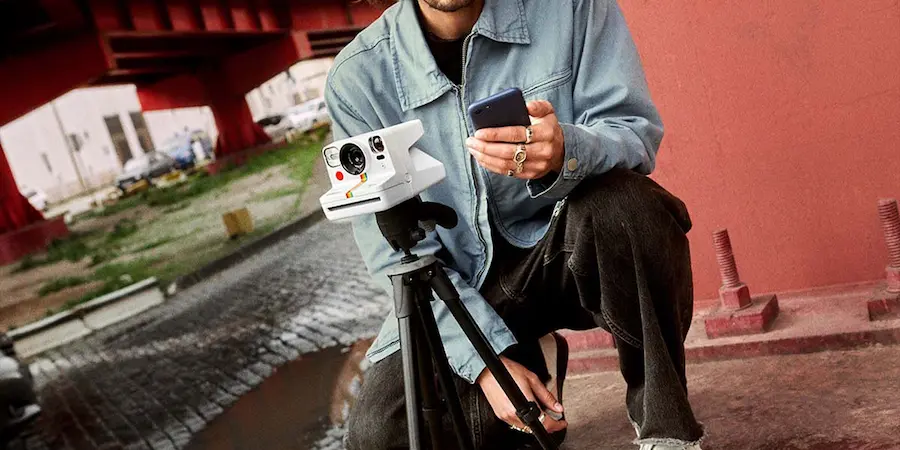The fever for images created with artificial intelligence shows no signs of slowing down: after Ghibli-style portraits or figurine-like boxed dolls, what’s now sweeping the scene are “souvenir” Polaroids with your favorite artist. The charm is that they don’t look like composites, but natural snapshots with that nostalgic touch we associate with instant cameras. Who wouldn’t want one of those on the fridge?
What’s behind the Polaroid effect that’s winning over social media
The trend consists of generating a photo that looks like it was taken with a real Polaroid: a casual framing, a slight blur that softens imperfections, and uniform lighting like a flash in a dark room that floods the scene. The result conveys authenticity, as if someone had captured an everyday moment without much preparation, and that’s exactly why it deceives the eye so well.
Moreover, realism has reached such a high level that many of these images circulate as if they were genuine memories. On TikTok and X, thousands of users share their creations with tags like #PolaroidIA and #GeminiFlash, showing off those “impossible moments” that AI turns into something believable. The aesthetic is direct and unpretentious: no impossible poses or complex sets, just two people seemingly together in a neutral place, with the typical flash snap we imagine in an old instant photo.
If you like to tinker with technology, the process will sound like adjusting controls as you would in Photoshop or fine-tuning the white balance on a DSLR: you define the style, set the light and let the machine do its thing. The difference is that here the “camera” is an AI model that interprets your request to return a photograph with an analog look without you having to learn tone curves or wrestle with layers.

How to create your Polaroid with a celebrity using Gemini
To hop on the train, the most direct route is Gemini. Access it via the app or the official website and sign in with your Google account; from there, the flow is simple. First, upload two images: one of you and another of the celebrity you want to pose with “as if it were real”. Then, define the request with a clear prompt, explicitly asking for the Polaroid style.
It works especially well to describe three key ideas: 1) that the scene looks like an ordinary photograph, without a grand theme, 2) that it includes slight blur and consistent flash-style indoor lighting, and 3) that faces and expressions remain intact. To reinforce the illusion, add a contextual detail: replace the background with white curtains and position yourselves very close, in an embracing pose. With those instructions, the AI tends to produce a composition that feels spontaneous and familiar.
Prefer to express yourself in English? No problem: you can make the same request in that language while keeping the aesthetic intent, flash-style lighting, soft blur, white curtain background and the request not to alter faces. Generate the image and evaluate the result; if it doesn’t nail the atmosphere on the first try, repeat with small variations in the text until you achieve the optimal mix of sharpness, grain and naturalness. Think of it like adjusting exposure and contrast sliders: a couple of iterations make the difference.
The last step is almost a patience game: iterate. Change nuances in the prompt to emphasize what convinces you most (“a bit more blur”, “softer flash”, “slightly tighter framing”), generate again and compare. In a matter of minutes you’ll have a believable virtual Polaroid ready to share.
The viral wave: hashtags, tricks and why it’s so addictive
Once you have your image, join the conversation on social media: the hashtags #PolaroidIA and #GeminiFlash gather thousands of posts on TikTok and X, confirming that we’re facing one of the year’s creative currents. The common thread is always the same: apparent simplicity, a sense of memory and a finish that could have come from a real instant camera.
When crafting your request, remember the keys that best connect with the effect: natural composition without stiff poses, uniform flash light that illuminates evenly and a neutral background like a white curtain so nothing distracts. Avoid asking for changes to faces or expressions; that facial stability is what completes the illusion. And if you want an even more “analog” touch, you can add in the text that the border should have the classic Polaroid frame, just like you would if you activated a frame in a mobile editing app.
Ultimately, this trend combines nostalgia and technology in perfect doses: the warmth of an instant memory with the flexibility of a modern image generator. It’s the same pleasure we feel when assembling a maker board project and watching it come to life, but applied to photography: you give precise instructions, hit “generate” and, as if by magic, that memory that never happened appears. If you’re intrigued by creative AI and enjoy experimenting, few things are more satisfying than seeing your “fake” Polaroid pass for real at first glance.
With current tools like Gemini (and, in general, conversational AI assistants like ChatGPT), you can play with your digital identity and create images with a professional look without being an editing expert. And the best part is that, by leaning on well-crafted descriptions, you get consistent results that look as authentic as a classic instant shot. Ready to try and share your own “impossible” Polaroid?

